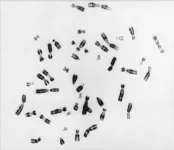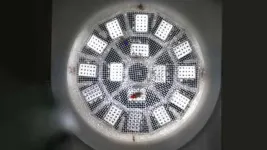(Press-News.org) A 3,500-year-old suit of Mycenaean armour may have been used in battle - and not just for ceremonial purposes as previously thought – new research reveals.
Researchers worked with a group of Greek military volunteers who wore a replica of the Dendra armour during extended simulations of the rigours of battle.
One of the best and most complete examples of Mycenaean-era full-body armour, the bronze panoply was discovered in a tomb in the Greek village of Dendra, by Greek and Swedish archaeologists in the 1960s. But since its discovery, the question has remained as to whether the armour was purely for ceremonial purposes, or for use in battle.
This question has limited historians’ and academics’ understanding of ancient warfare and its consequences, which underpinned the social transformation of the prehistoric world.
But now, new research from an international team of researchers, published in PLOS ONE, has found that the armour was suitable for active warfare, providing new insights into war in the Late Bronze Age.
The research team conducted human experiments with a metal replica of the armour, which was created in the 1980s by staff and students at the former Bournville College of Art in Birmingham, UK at the invitation of the late Diana Wardle. A group of Greek special armed forces personnel wearing the replica armour completed an 11-hour simulation of Late Bronze Age combat protocols based on details from Homer’s Iliad.
Professor Andreas Flouris, from the University of Thessaly, who led the research said: “The armour that our volunteers wore was the same dimensions and similar weight to the Bronze Age original. We also monitored calorie intake based on a ‘Homeric diet’ (about 4,443 calories) derived from relevant descriptions found in the Iliad, and calorie expenditure together with the stresses placed on the volunteers’ bodies under temperatures typical for a Greek summer of 30-36 degrees Celsius. When the 11-hour battle protocol began we measured heart rate, oxygen consumption, core temperature, fluid loss, and muscular function.
“We found that the armour allowed full flexibility of movement and did not exert excessive physiological stress on the body. This means that despite earlier views which classified it as only a ceremonial outfit, the armour could be worn for extended periods by fit individuals in battle. Sixty years on from the discovery of the Dendra armour we now understand, despite its cumbersome appearance at first sight, that it is not only flexible enough to permit almost every movement of a warrior on foot but also resilient enough to protect the wearer from most blows.”
The findings add much-needed detail to contemporary historical records of armour found in Greece and Egypt – records such as numerous sketches of armour on Linear B tablets (syllabic script used for writing Mycenaean Greek) found at Knossos in Crete, as well as illustrations of Mycenaean warriors on Egyptian papyrus.
The researchers argue that findings from these experiments show that the Mycenaeans had such a powerful impact in the Eastern Mediterranean in part because of their armour technology.
Dr Ken Wardle, Senior Lecturer in Classics, Ancient History and Archaeology at the University of Birmingham who collaborated on the study, explained: “Hittite records of military interactions with the Ahhiyawa, another name for the Mycenaeans, show that they had a substantial presence in western Asia Minor in the second half of the 2nd Millennium BC. Given that the Hittite kingdom dominated most of Anatolia and, at times, the northern parts of Syria and Mesopotamia we must understand that only a significant military force could oppose them or gain such respect as recorded in the Hittite archives.
“Descriptions of bronze armour used in the Iliad were thought to be later interpolations or poetic license, but this research suggests otherwise. Viewing the armour in light of these historical records, knowing that it is possible it was used in battle, helps to shed much-needed light on one of history’s most momentous turning points: the collapse of the Eastern Mediterranean Bronze Age civilisations towards the end of the 2nd Millennium BC; a time of destruction and upheaval that marked the beginning of the Age of Iron.”
ENDS
END
Having extra chromosomes is typically an issue for an organism and can disrupt development or cause disease. But some cells benefit instead: For example, cancer cells or pathogenic yeasts can use extra chromosomes to escape treatment and become drug-resistant. A team of researchers from Charité – Universitätsmedizin Berlin has now deciphered how yeasts manage to compensate for the genetic imbalance. Their findings, published in the journal Nature,* could yield new approaches to dealing ...
SAN ANTONIO — May 22, 2024 — Southwest Research Institute will share the latest developments from its ongoing NEXTCAR Phase II project at the 2024 ARPA-E Energy Innovation Summit in Dallas (May 22-24). The Institute’s NEXTCAR Program aims to reduce vehicular energy consumption by more than 30% using next generation connected and automated vehicle (CAV) technology.
“We are demonstrating real-world next-generation automated driving technology that puts SwRI’s ongoing NEXTCAR energy efficiency research into practice,” said SwRI’s Scott R. Hotz, P.E., director of the Powertrain ...
Background and Aims
Three-dimensional power Doppler (3DPD) ultrasound has been used for assessing adnexal masses, and in this study, we aimed to perform a meta-analysis to evaluate its role in the differential diagnosis of adnexal masses.
Methods
A search for primary studies assessing the diagnostic performance of 3DPD in discriminating benign from malignant masses carried out between January 1990 and May 2023 was performed in Medline (PubMed), Scopus, and Web of Science databases with study quality evaluated ...
EMBARGOED UNTIL 12:01 a.m. EST Wednesday, May 22, 2024
Contact:
Jillian McKoy, jpmckoy@bu.edu
Michael Saunders, msaunder@bu.edu
##
During extreme rain or rapid snowmelt, the high volume of water that enters sewer systems can cause untreated sewage to flow into waterways in US cities that have combined wastewater and stormwater sewer systems, including the Merrimack River in Massachusetts.
A new study led by Boston University School of Public Health (BUSPH) researchers has found that residents living in the downstream communities that ...
Scientists have uncovered the properties of a rare earth element that was first discovered 80 years ago at the very same laboratory, opening a new pathway for the exploration of elements critical in modern technology, from medicine to space travel.
Promethium was discovered in 1945 at Clinton Laboratories, now the Department of Energy’s Oak Ridge National Laboratory, and continues to be produced at ORNL in minute quantities. Some of its properties have remained elusive despite the rare earth element’s ...
We’ve been told, “The eyes are the window to the soul.” Well, windows work two ways. Our eyes are also our windows to the world. What we see and how we see it help determine how we move through the world. In other words, our vision helps guide our actions, including social behaviors. Now, a young Cold Spring Harbor Laboratory (CSHL) scientist has uncovered a major clue into how this works. He did it by building a special AI model of the common fruit fly brain.
CSHL Assistant Professor Benjamin Cowley and his team honed their AI model through a technique they developed called “knockout training.” ...
Metals get softer when they are heated, which is how blacksmiths can form iron into complex shapes by heating it red hot. And anyone who compares a copper wire with a steel coat hanger will quickly discern that copper is much more pliable than steel.
But scientists at MIT have discovered that when metal is struck by an object moving at a super high velocity, the opposite happens: The hotter the metal, the stronger it is. Under those conditions, which put extreme stress on the metal, copper can actually be just ...
About The Study: In this study, death by firearm homicide was concentrated among Black individuals ages 15 to 24 before, during, and subsequent to the COVID-19 pandemic, implying that there are likely to be social and structural conditions that contribute to these racial disparities.
Corresponding Author: To contact the corresponding author, Alex R. Piquero, Ph.D., email axp1954@miami.edu.
To access the embargoed study: Visit our For The Media website at this link https://media.jamanetwork.com/
(doi:10.1001/jamanetworkopen.2024.12946)
Editor’s ...
About The Study: The findings of this study suggest that mental disorders might be transmitted within adolescent peer networks. More research is required to elucidate the mechanisms underlying the possible transmission of mental disorders.
Corresponding Author: To contact the corresponding author, Jussi Alho, Ph.D., email jussi.alho@helsinki.fi.
To access the embargoed study: Visit our For The Media website at this link https://media.jamanetwork.com/
(10.1001/jamapsychiatry.2024.1126)
Editor’s Note: Please see the article ...
A landmark longitudinal study of LGBTQ+ youths has found that transitioning gender identities is not associated with depression and that about 1 in 3 gender-minority youths change their gender identity more than once. In fact, the study found higher rates of depression among transgender youths are more closely associated with bullying and victimization.
The findings from a team of researchers at The University of Texas at Austin and in Brazil are outlined in a paper in JAMA Network Open.
The study followed 366 LGBTQ+ young people ages 15-21 in two U.S. cities from 2011 to 2015 and measured depressive symptoms ...





